Cork floors: advantages and disadvantages, step-by-step installation, aftercare
Cork flooring is a natural floor covering. The bark of the cork tree is used for its production.The structure makes the coating warm, resilient and elastic. The pros and cons of cork flooring do not end there, which allows it to displace popular linoleum or laminate.
The content of the article:
What is it like?
To produce cork flooring, they take the bark of cork trees, for example, Western oak. The peculiarity of the tree is that its bark can be removed, and after a few years it grows back. This procedure can be carried out up to 20 times on one plant. Each time the material becomes better.
The resulting bark is crushed into crumbs, which are exposed to high temperatures. Next, using the pressing method, sheets are pressed from the resulting crumbs. They are glued with other layers (vinyl, reinforced, varnish).
There are 2 types of coverage:
- Adhesive tiles. This option is the most environmentally friendly. It consists of veneer and agglomerate. Solid pressed tiles are produced in different sizes. Their thickness is from 3 to 6 mm. Special glue is used for installation. The mounted tiles are opened with varnish. The panels are highly water resistant, so they are used for kitchen and bathroom renovations. Since the material can withstand temperature fluctuations, it is suitable for use in non-residential premises that are not heated.
- Floating. Another name is castle floor.The principle of its installation is similar to the installation of laminate. The tile consists of veneer, agglomerate and dense fiber-wood board. For some models, the covering may be made of leather or valuable wood. Printing possible. This type does not require additional processing after installation. Its use is allowed in dry rooms where there are no changes in humidity or temperature.
Interlocking and adhesive cork floors have a number of differences that are taken into account when choosing a material:
- Terms of Use. The locking plug is suitable for dry rooms. The adhesive version can withstand fluctuations in humidity and temperature.
- Foundation quality. Adhesive requires an even, smooth coating for installation. It is permissible to lay it on a screed. Tile, plywood, parquet or laminate are not suitable as a base. To prevent gaps from appearing between the sheets, it cannot be mounted if the room temperature is above 28 degrees. The locking plug can be laid on an uneven surface (with differences of up to 2-3 mm). Installation on tiles, parquet or linoleum is acceptable.
- Difficulty in installation. Installing adhesive flooring requires certain skills. Therefore, a beginner cannot cope with this. After installation, varnish is applied on top (2-3 layers for rooms with light load, 4-5 for increased load on the surface). The lock option is floating. When laying it, a locking connection is used, which makes it easy and quick to install it yourself.
- Thermal insulation. Both options have a high degree of thermal insulation. But for cold rooms it is recommended to choose the adhesive option. You can install a “warm floor” underneath it.
- Soundproofing. Both options have the same degree of sound insulation.
- Appearance.Glue plug allows you to show your creativity. The panels can be cut, tinted, and then laid, creating different textures, combinations of shapes or shades. It will not be possible to perform an artistic installation of the castle floor.
- Operating period. With an adhesive plug, it is almost unlimited, provided that it is properly cared for. Interlocking cork flooring has a service life of 7-10 years.
- Possibility of restoration. Replacing a damaged sheet of adhesive plug is not difficult, but problems may arise with the locking structure. During operation, its connections can swell from moisture or become deformed. Therefore, it will no longer be possible to reassemble the structure.
- Price. The average price of the adhesive type is lower than the lock type. But for its installation you will need additional materials (glue, varnish). Therefore, their price will be approximately the same. But for laying the adhesive version, experts ask 30% more.
Advantages and disadvantages
When choosing a cork flooring, take into account its pros and cons. Advantages:
- Warm surface. The material consists of small cells containing air inside. Therefore, cork coating has low thermal conductivity - it always remains warm. This allows you to use it to decorate a children's room or bedroom. The surface will be warm to the touch.
- Noise insulation. The porous structure absorbs sounds well. Therefore, neighbors from the apartment below will not hear stomping or other sounds.
- Can be used in any room (bedroom, living room, study, kitchen, bathroom). Cork flooring can be installed in unheated rooms (country house, balcony).
- Practicality.The floor is constantly exposed to high loads, so its coating must be wear-resistant. It is elastic and can quickly restore its shape if deformed.
- Comfortable movement and anti-slip effect. The elasticity helps reduce the load on the spine while walking on it. And in case of a fall, it will soften the blow.
- Environmental friendliness. This is a natural component, so it does not harm the health of people living in the house.
- Natural look. Cork flooring has a natural look that may seem boring. For such buyers, the manufacturer offers options in different shades.
- Easy to care for. Cleaning up a room with a cork floor is not difficult. It is enough to vacuum it and then wipe it with a damp cloth to return it to its cleanliness and original appearance.
Flaws:
- Furniture and heavy objects leave dents in the coating.
- Rough surface. Users note that when moving around it in socks, they quickly wear out. However, this only applies to floors varnished with the addition of ceramic chips. This material makes the coating durable. To avoid this drawback, it can be treated with fine sandpaper and then varnished.
- Price. According to customer reviews, cork flooring is expensive. This applies to both the material itself and the price of its installation. But, if you consider all the advantages, it will not seem so expensive.
Dispelling myths
Cork has only recently been used as a flooring material. Therefore, many still have concerns about its use. Let's look at the most common myths to prove that all fears are in vain.
Coating fragility
It is believed that cork is fragile, so this coating cannot withstand daily stress.However, this material has a honeycomb structure. Therefore, it is practically invulnerable and can retain its appearance and other qualities for decades.
Cork can regain its shape. But provided that the damage did not occur as a result of a sharp blow with a heavy object.
It can lose its shape if it is exposed to heavy furniture for a long time. To avoid this, you need to place felt under the cabinet legs.
Instability due to temperature changes
The material can easily withstand temperature fluctuations. Therefore, it is suitable for installation on a balcony or in an unheated room.
For such cases, choose the adhesive option. It is characterized by energy-saving properties, since its surface is always warm to the touch.
Suitable for residential use only
There is an opinion that cork is fragile, so it cannot be used when decorating sales areas or offices. But there are many examples when the material was used in the interiors of public buildings.
For example, the floors in American government buildings, the interior of which has not been changed for 100 years, are covered with cork. It can be seen in the decoration of many shops, gyms, hospitals and airports.
Not suitable for homes with pets
A floor made of cork, which is additionally coated with varnish, is difficult to scratch. The advantage of cork flooring for pet owners is its sound-absorbing properties, which will make the clicking of claws on such a surface silent.
Cork does not tolerate moisture
Cork floors withstand high humidity and the use of household chemicals well. Therefore, it is used in the bathroom, gyms, etc. An exception would be saunas and baths.
The advantage of the coating will be the anti-slip effect.Therefore, you won’t be able to slip even on a wet floor. But in rooms with high humidity, it is necessary to choose an adhesive type, additionally coated with varnish.
Suitable for children's rooms only
Cork flooring is hypoallergenic, hygienic, and environmentally friendly. Therefore, it is chosen for children's rooms. But the designers have proven that all the positive qualities are appropriate in other rooms:
- Kitchen. It is comfortable to walk on it while cooking. The material does not absorb liquid or foreign odors. To make it unpretentious and more stable, use polyurethane varnish.
- Bedroom, living room. The rooms will become more comfortable with cork flooring.
- Hallway. An attractive appearance and practicality will be appropriate here.
- The office will be more comfortable thanks to the silence and warmth that the cork will provide.
- Gym. The elasticity of the product will be useful here.
Impracticality
Cork flooring has been called impractical. There is an opinion that it is difficult to clean. But those who have already used this material refute this statement:
- the cork does not attract dust as it has an antistatic effect;
- the material does not absorb odors and moisture;
- the floor is resistant to grease and stains from wine and coffee;
- the coating does not deform under the influence of liquid.
For cleaning you will need a vacuum cleaner and a cloth.
High price
The floor faces high loads every day. In this case, the coating rarely changes. Therefore, it is necessary to choose quality materials.
If you compare the price of cork with other floor coverings, it is almost no different from laminate or parquet. At the same time, it allows you to save on installing “warm floors” and paying for electricity, since the material is warm and pleasant to the touch.
Cork flooring only for eco-style in the interior
The coating is suitable for many interiors. Its advantage is that it can be combined with various materials. Cork has different shades and repeats different textures, filling the house with a cozy and warm atmosphere.
Monotonous look
New technologies make it possible to apply various patterns to cork. Therefore, it may be impossible to guess what the floor is made of. In this case, all properties are preserved.
Floor care
Cork flooring has many advantages. But in order for it to last longer without losing its appearance and quality, it needs to be properly cared for. It’s not difficult to do, just follow the rules:
- Caring for the coating must begin immediately after its installation. To improve the appearance and prevent damage, a protective compound is applied to the surface.
- Cork is best preserved at a temperature of 20-25 degrees and a humidity of about 50%. In winter, when indoor humidity decreases, it is recommended to use room humidifiers.
- For cleaning, a regular vacuum cleaner and a damp cloth are enough. If household chemicals are used, you need to make sure that they do not contain aggressive substances and that they are suitable for cork.
- It is not recommended to use hard brushes to remove dirt and stubborn stains. You need to take a fine skin. The cleaned area is opened with a layer of varnish or wax.
- If there are no special means for cleaning the cork, the dirt can be removed with a regular school eraser. You can also use dishwashing detergent. It is diluted with water in a ratio of 5 ml of liquid per 1 liter of water.
- If contamination from drinks or food appears on a cork floor, it must be removed immediately. Once absorbed, it will be more difficult to get rid of them.
- To prevent the cork from losing its appearance, it is necessary to protect it from exposure to ultraviolet radiation.
Laying step by step
Cork is an expensive material, so mistakes during its installation can be costly. If you decide to save on the services of a professional and install the cork floor yourself, you need to familiarize yourself with the process.
In order for a cork floor to last longer, you must adhere to the requirements for the base under the cork covering:
- The base for the coating must be level. The difference can be no more than 2 mm per 1 m2.
- To prevent condensation from accumulating below, the coating must be hydrolyzed. To do this, a perforated layer is laid underneath.
- Cork flooring cannot be laid on concrete. The substrate must be laid.
The following tools and components are required for work:
- Substrate.
- Glue. Only special formulations are suitable.
- Leveling mixture for creating a rough screed. If it is intended to be laid on a wooden floor, it must be peeled off and plywood placed on top.
- Mesh for reinforcement, beacons, level, rule, mixer for cement work.
- Roller, construction knife, spatula, mallet for installation.
- Roulette, square.
To prepare the base you need:
- Remove the old coating (if any). Cork flooring can be installed on a wooden floor or linoleum if they are in good condition. But it is better to do this on a concrete screed.
- The concrete screed is cleaned, moistened and primed. This is necessary for better adhesion to the coating.
- Beacons are placed on the screed. A reinforcing mesh is laid on top. Afterwards the prepared solution is poured.
After the solution has dried, installation can begin. Before this, it is recommended to bring the material into the room for acclimatization.The installation work depends on the chosen plug shape:
- First, the substrate is laid. Its sheets are overlapped. Construction tape is used to secure them. To compensate for possible expansion, the edges of the substrate extend beyond the edge of the wall.
- The adhesive composition is mixed. It must be prepared in small portions, which are used immediately.
- The castle floor is installed starting from the far corner. Laying boards is similar to laying laminate flooring. In this case, each panel is inserted into the adjacent one and hammered in with a mallet.
- When laying a solid cork sheet, first apply glue and smooth it out using a notched trowel. Afterwards a sheet is laid, which is tapped along the edges and in the middle part. Glue protruding at the joints is removed immediately, as it can cause a change in shade.
- Cork tiles are laid in the same way as a solid sheet. Only the installation begins from the middle of the room, moving towards the corners in a spiral.
After laying the cork floor, it must be covered with several layers of varnish. It can be matte or glossy.
Cork flooring has a beautiful appearance and high performance. In addition, reviews prove its reliability. The material is suitable for decorating all types of premises and looks equally good in any interior.
Do you like cork flooring? Share your opinion in the comments. Save the article in your bookmarks so that useful information is not lost.
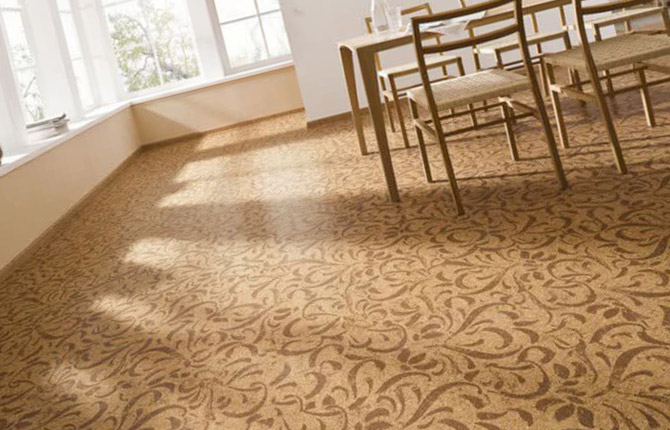

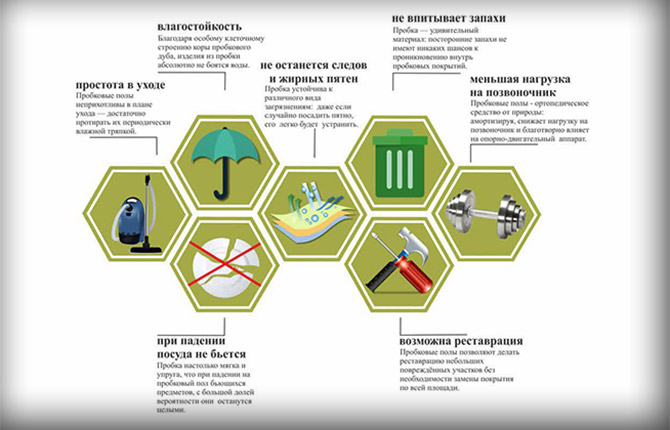

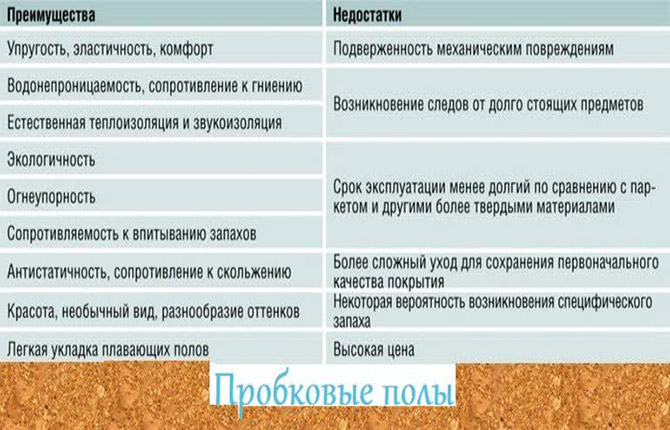
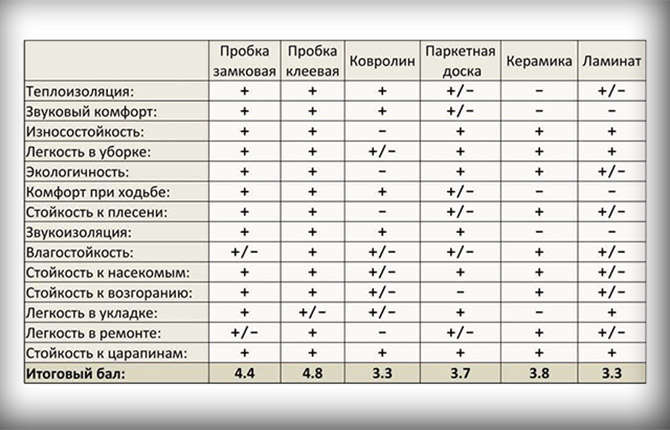

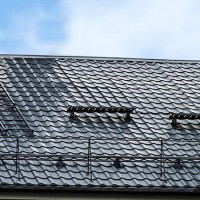



My wife and I also chose cork flooring. The material really cannot be called cheap. But we managed to save money on its installation. I did the editing myself, following video tutorials on the Internet.
When we were renovating the children's room, we chose cork flooring, as it is always warm and does not cause allergies. Now I plan to do the same in other rooms.